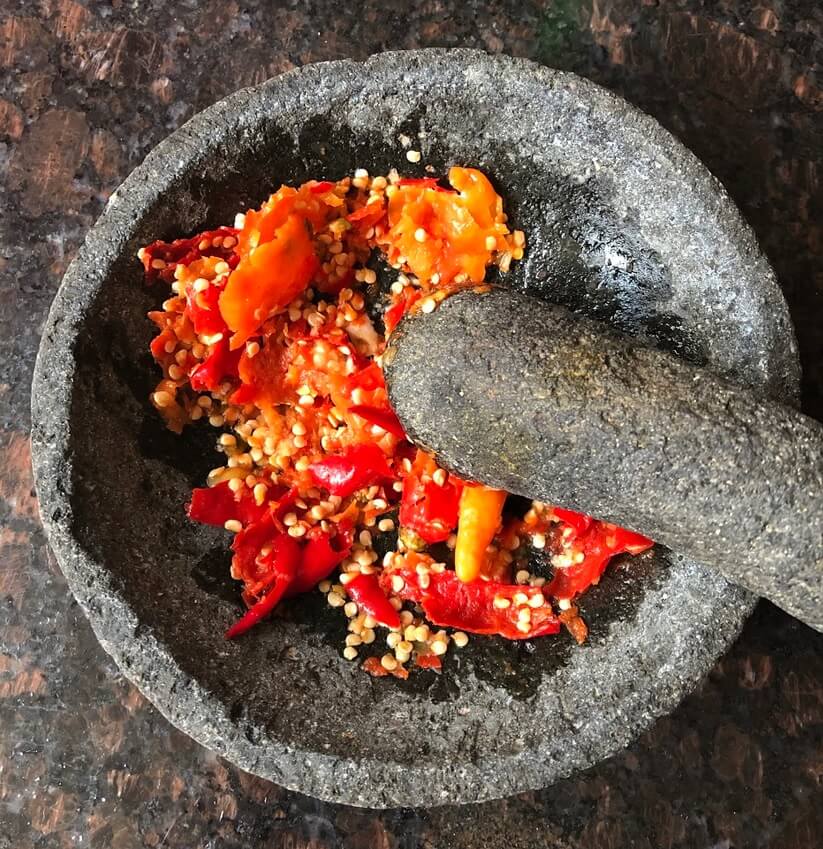
It’s time to cook Indonesian food!
To get you started, here’s a list of cookware and kitchen tools that’ll help you make almost any Indonesian dish. We’ve divided the list into ‘Must Have’ and ‘Good to Have’, and have suggested substitutes for hard-to-find equipment.
Must have
Wok
When it comes to cookware, there’s nothing more versatile than a wok. It’s good for deep-frying, stir-frying, sauteing, and even making stews and gravies. In Indonesia, woks are used for almost every cooking method, except for maybe boiling and steaming. One thing I personally like about a wok is, it allows for any quantity of oil one might desire, in contrast with a flat frying pan, where the entire base needs to be coated with oil. When sauteing a small quantity of spice paste, or cooked sambals like sambal tomat, I use just enough oil to cover the base of the wok and then swirl it around to coat the sides a little.
These days, woks come in a variety of materials, but the best is still the traditional cast iron wok. Cast iron woks tend to be very heavy, which makes them a pain to lift, but they’re extremely stable on the stove. They also conduct heat well without burning easily, unlike cheap aluminium. Before using a wok, my family usually fills it with tamarind water and lets it rest overnight. The wok is then coated with oil, as a preliminary step, before it is ready to be used. Cast iron woks last a really, really long time too – I personally have never bought one, because my family wok has been around forever and doesn’t need to be replaced.
If a wok is unavailable, you’ll need these implements instead: a deep-fryer, and either a frying pan or a casserole dish.
Pot or Casserole Dish
As soups and stews are a big part of Indonesian cuisine, you’ll need some sort of cookware that can hold water.
Steamer
A good number of Indonesian dishes are steamed, including many desserts and cakes. Any steamer will do the trick.
Mortar & Pestle
Indonesian cuisine consists of a lot of pastes, which means a lot of grinding and pounding. Traditionally, pastes are made using a mortar and pestle but can, today, be made using a blender or food processor as well. A mortar and pestle set has its advantages, though, such as greater control over how coarse or fine you want your paste to be, and allows for smaller amounts to be worked with. It’s also the best option for sambals, especially raw ones like sambal terasi.
Traditional Indonesian mortar and pestle sets come in two shapes: a completely flat one, and one that is slightly concave. These are difficult to find outside of Indonesia, but any other type of mortar and pestle can be used as well.
Pounding using a mortar and pestle can be a lot of work, though. If you can’t find a set, or are lazy or short of time, you can always use a blender or a food processor.
Blender/Food Processor
Although a mortar and pestle is traditionally used, most modern Indonesian kitchens will also have a blender or a food processor. Blenders, especially, are fantastic if you need to make a smooth paste, something that requires an inordinate amount of energy with a mortar and pestle.
When using a blender, many Indonesian chefs recommended blending spice pastes with oil instead of water. Because the blended paste usually needs to be sauteed, blending with water might result in boiling the paste instead of frying it.
Grater
A grater is indispensable for dishes containing palm sugar, like kolak pisang – palm sugar tends to come in rock-solid blocks although only a small amount is needed at a time. Grated coconut is also a common ingredient in Indonesian cooking, and you’ll need to grate it yourself if you can’t find pre-packaged grated coconut at the store. Sometimes, a grater is also used for things like lime zest, or cheese in Dutch-inspired dishes.
Spatula & Ladle
A spatula for frying, and a ladle for soups and stews.
Tongs
A pair of tongs can be immensely useful, especially for deep frying. Tongs will allow you to easily turn your ingredients over when cooking, for example, when making ayam goreng (fried chicken) or other fried dishes.
A large strainer
A large strainer is useful not only when draining liquids, but also when deep-frying, to drain the oil. In Indonesia, the typical procedure for deep frying is as follows: (1) Hold the tongs with one hand, (2) Hold the strainer with the other, keeping it directly above the wok, and (3) pick the fried item up with the tongs and place it in the strainer, allowing excess oil to drain right back into the wok to prevent wastage.
Colander
For rinsed vegetables, but also extremely useful for straining noodles in dishes like bihun goreng.
Dessert moulds
To get started on Indonesian pudding and cakes, you’ll need some form of dessert mould…perhaps even more than you’ll need an oven! For example, like many Indonesian desserts, agar-agar, uses a pudding mould but requires no baking at all.
Good to have
Rice cooker
Indonesians eat rice with everything, including noodles! If you’re planning on cooking Indonesian food on a regular basis, a rice cooker will change your life, if only because it keeps your rice warm while you do other things.
Pressure cooker
Most Indonesians don’t use pressure cookers, but these can be very helpful in reducing your cooking time, especially for time-consuming dishes like rendang.
Grill
Although many Indonesians don’t have a grill at home, mouth-watering grilled dishes such as sate and ikan bakar (grilled fish) feature prominently in Indonesian cuisine. A grill will give you access to almost all of Indonesian cuisine.